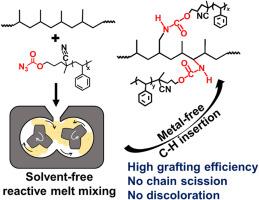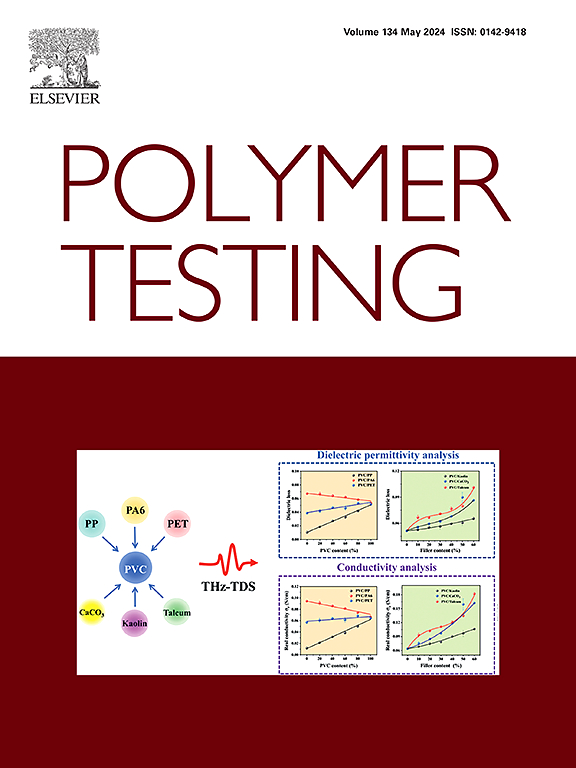利用叠氮化物的 C-H 插入改性聚烯烃:用于改性聚丙烯的叠氮甲酸酯末端官能化聚苯乙烯
IF 5
2区 材料科学
Q1 MATERIALS SCIENCE, CHARACTERIZATION & TESTING
引用次数: 0
摘要
聚烯烃在全球塑料工业中占据主导地位,约占所有商用塑料的 60%。然而,其有限的化学功能性限制了其在粘附性、印刷性和相容性方面的应用。为了克服这些限制,本研究探讨了通过叠氮甲酸酯(AF)基团的 C-H 插入对聚丙烯(PP)进行无金属、熔融过程、聚合后改性的方法。具体来说,我们研究了将 AF 端部官能化的聚苯乙烯(PS)接枝到聚丙烯上的方法,并成功制备出了具有有趣特性的新型聚丙烯杂化物,包括因接枝而增强的聚丙烯和 PS 成分之间的相容性、较小的聚丙烯结晶尺寸、较高的杨氏模量和弹性流变行为(这可能归因于 PS 支链的存在)。重要的是,所提出的方法避免了聚丙烯链的断裂和产品的不良着色,为传统聚烯烃的工业转化提供了一条前景广阔的途径。这项研究为开发具有更佳性能和潜在环境效益的聚烯烃基混合材料铺平了道路。本文章由计算机程序翻译,如有差异,请以英文原文为准。

Modification of polyolefins utilizing C–H insertion of azides: Azidoformate end-functionalized polystyrene for modifying polypropylene
Polyolefins dominate the global plastics industry, constituting roughly 60% of all commercial plastics. However, their limited chemical functionality restricts their applicability in adhesion, printability, and compatibility-dependent applications. To overcome these limitations, this study investigated metal-free, melt-process, post-polymerization modification of polypropylene (PP) via C-H insertion of azidoformate (AF) groups. Specifically, we investigated grafting of AF end-functionalized polystyrene (PS) onto PP and demonstrated the successful preparation of novel PP hybrids with interesting properties, including enhanced compatibility between PP and PS components due to grafting, smaller PP crystallite size, high Young's modulus, and elastic rheological behavior, likely attributable to the presence of PS branches. Importantly, the presented approach avoids chain scission of PP and undesirable coloration of the product, offering a promising pathway for industrial transformations of conventional polyolefins. This research paves the way for developing polyolefin-based hybrid materials with enhanced properties and potential environmental benefits.
求助全文
通过发布文献求助,成功后即可免费获取论文全文。
去求助
来源期刊

Polymer Testing
工程技术-材料科学:表征与测试
CiteScore
10.70
自引率
5.90%
发文量
328
审稿时长
44 days
期刊介绍:
Polymer Testing focuses on the testing, analysis and characterization of polymer materials, including both synthetic and natural or biobased polymers. Novel testing methods and the testing of novel polymeric materials in bulk, solution and dispersion is covered. In addition, we welcome the submission of the testing of polymeric materials for a wide range of applications and industrial products as well as nanoscale characterization.
The scope includes but is not limited to the following main topics:
Novel testing methods and Chemical analysis
• mechanical, thermal, electrical, chemical, imaging, spectroscopy, scattering and rheology
Physical properties and behaviour of novel polymer systems
• nanoscale properties, morphology, transport properties
Degradation and recycling of polymeric materials when combined with novel testing or characterization methods
• degradation, biodegradation, ageing and fire retardancy
Modelling and Simulation work will be only considered when it is linked to new or previously published experimental results.
 求助内容:
求助内容: 应助结果提醒方式:
应助结果提醒方式:


